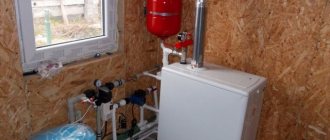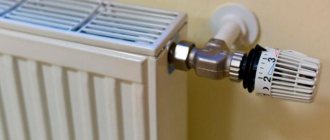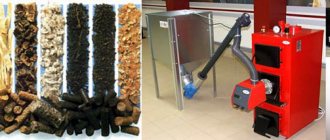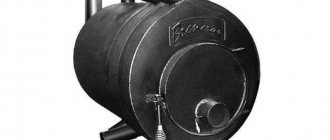Expansion tanks (the technical name of the device is expansion tanks) are produced for various heating systems (HC). For open ones, containers in the form of an ordinary metal or plastic barrel without a lid are required. Such devices are used, as a rule, in gravitational systems.
For closed systems, modern, sealed tanks with an elastic diaphragm (membrane) are used, mounted in a CO with a pump, in any place in the pipeline convenient for placement. Today’s publication will talk specifically about membrane expansion tanks for heating, their types, methods for calculating capacity and the stages of their installation.
Purpose, design and operational features
An expansion valve is a device designed to compensate for the expansion of the coolant when heated. In other words: if this reservoir is not provided, the liquid that has expanded under the influence of temperature will have nowhere to go and it will rupture the pipes, radiators, and heat exchanger of the boiler unit, creating a danger of explosion.
In addition, no matter how sealed the CO is, the coolant still evaporates from it. Its quantity in the circuit decreases, which significantly reduces the efficiency of heating the home. A membrane expansion tank for heating allows you to replenish the volume of liquid while maintaining the necessary tightness in the system.
The design of this device consists of a steel, corrosion-resistant tank, in which there is an elastic diaphragm in the middle. This tank contains a spool valve for pumping the required pressure, a safety valve and a pipe connecting the device to the CO.
What pressure should be in the expansion tank
When arranging a heating system, it is necessary to pay attention to absolutely all aspects, from the design of the heating unit to its configuration. Among the variety of functional elements, the vacuum expansion tank for heating plays an important role in creating high-quality heating equipment. Thanks to this device, the volume of coolant is adjusted, which makes it possible to prevent rupture of the heating main, radiators and shut-off valves.
1
Unit design
Storage tanks for heating are cylindrical or square containers with pipes cut into the body. Their number depends on the number of connected circuits and heating devices.
The volume of the container depends on the area of the heated room and ranges from 200 to 3 thousand m³. To preserve heat, between the tank and the outer casing there is a thermal insulation material with a thickness of 5 to 10 cm. Depending on the design, the following elements are located inside the tank:
- one or more heat exchangers;
- tubular electric heater;
- magnesium anode.
Heat exchangers are used in dual-circuit systems. In the design of a hot water storage tank, these elements are coils made of copper pipes. Electric heaters help maintain the temperature of the coolant if the boiler fails for a short time.
How to calculate an expansion tank for a closed heating system
Types of closed expansion machines
The “first fiddle” in this device is played by the diaphragm, which, depending on the model, can be replaceable or fixed.
- In the first case, the shape of the membrane resembles a pear or balloon. That is why containers of this type are called “balloon”. Repair of the heating expansion tank and replacement of a worn-out diaphragm are carried out through a flange with a water pipe located at the bottom of the device.
- With a fixed diaphragm design, the membrane is attached in the middle of the body, after which the tank is sealed at the factory, making it impossible to replace it. Repair of this type of tank (replacement of the blast valve, pipe) is carried out only in specialized workshops.
The only advantage of membrane devices over containers with a replaceable diaphragm is their low cost.
Important! Selecting an expansion tank for a heating system is an important process that requires precise calculations and experience. If you are unsure of your knowledge, then contact a professional.
Operational Maintenance
It must be remembered that during breaks in use, the tanks, like other components of the heating system, should be emptied and then dried. This point should not be ignored, as failure to comply will lead to corrosion and reduced service life.
When using any closed tank, owners should regularly perform a number of simple operations.
Which include:
- periodic inspections to detect corrosion and mechanical damage - this procedure should be carried out twice a year;
- checking the pressure in the system, which is performed every six months;
- periodic inspections of the integrity of the membrane - such operations are carried out according to the manufacturer’s recommendations.
And in addition, throughout the entire operation, users will have to comply with the requirements regarding permissible temperature and pressure standards.
To repair tanks, you should use only original components, as this will ensure not only the required performance, but also safety of use.
The following article will introduce you to the rules and features of selecting an expansion tank for open-type heating systems, which owners of houses with open heating circuits should read.
Advantages
There are many advantages of membrane expansion tanks over open containers. Experts highlight the following:
- These devices can be used in systems with tap water.
- Easy to replace a tank or a damaged diaphragm.
- Minimal maintenance.
- No evaporation, which means you can use cheap ethylene glycol.
The main advantage of these models, according to experts, is their high displacement capacity.
How does the expanzomat work?
The operating principle of a membrane expansion heating tank is ingeniously simple, and is as follows:
- In normal condition, the coolant level reaches the membrane. As it expands, it begins to press the diaphragm towards the gas chamber, which is under a certain pressure.
- As the coolant cools, its level in the container drops and the membrane returns to its working position.
If we consider the balloon “mechanism”, then when the level of liquid in the system rises, it enters the “bulb” of the tank. Gradually, it stretches, limiting the contact of liquid (water, antifreeze, brines) with the walls of the device. When the operating temperature of CO is reached, the pressure in the gas chamber squeezes the liquid into the system.
Thus, installing a membrane expansion tank for heating:
- Stabilizes the operation of CO during maximum expansion of the coolant and pressure surges when starting the boiler unit.
- Minimizes evaporation of liquid from the system.
- Allows you to work with both water and antifreeze.
What to do before setting up the tank
All listed pressures must be expressed in bars (1 bar = 10 m). Let's take as a basis a two-story house with a heating system height of 4 m.
The tank must be disconnected from the heating system or shut off with a tap. The pressure in the water chamber must be released. When pumping air, the system pressure should not exert its influence, otherwise the tank will not be able to be adjusted.
The same must be done when, before the start of the heating season, you check the pressure in the tank, or when you suspect that the tank has stopped working - the rubber bulb has leaked.
On the left we offer a diagram of connecting the tank to the heating system.
Does it make a difference how to install the tank: with the water pipe up or down? From the point of view of its operation and the dynamics of pressure changes in the heating system, there is no difference. But from the point of view of its operation: in the event of a membrane malfunction (when it is leaky), there is a difference.
If the tank is connected to the heating system with the water pipe facing up, then if the membrane fails, the tank will not be able to release water to the system, although it will be filled with water.
And if you connect it the other way around (with the water pipe down), then even if it is faulty, the expansion tank will still be able to release coolant.
How to calculate the volume of an expansion chamber
Calculating an expansion tank for closed-type heating systems is a rather serious process that can be done in several ways:
- Entrust the calculations to a certified specialist. The result is of fairly high quality, but you will have to pay a considerable amount for it.
- Using online calculators. The results are quite reliable. This option is for those who do not want to waste time and pay money. The only disadvantage of this calculation is that in case of incorrect data there is no one to file a claim with. And problems with incorrect calculation can be quite serious: from ineffective operation of the CO to its complete destruction, due to the smaller volume of the expansion tank than required.
- Do the calculation yourself, and it’s not that difficult.
Use the formula
V
= (
V
s *
Z
) /
N
where: V
s – volume of CO.
To calculate this value, you need to proceed from the fact that for every 1 kW of boiler installation power, 15 liters are needed. liquids. For example, your heat generator has a power of 45 kW, then the volume of CO will be 45 x 15 = 675 liters. Z
is a coefficient showing the expansion of a specific coolant at a certain temperature.
Water - 0.04; glycol antifreeze, (depending on the concentration of the active substance) from 0.044 to 0.048. The data is valid at a maximum temperature in CO of 95°C. N
– device efficiency indicator. Some manufacturers indicate this parameter. If it is not in the documentation for the device, then you can simply calculate it yourself using the formula:
N
= (
D
max -
D
min) / (
D
max + 1)
where: D
max – maximum pressure.
For household autonomous COs, this value is 2.5-3 kg/cm2; D
min – initial pressure in the air chamber of the device. This value is equal to 0.5 kg/cm2 for every 5 m. heights CO.
So:
N = (2.5-0.5)/(2.5+1) = 0.57
All data for calculations is available. Let's calculate the capacity of the expansion tank for CO of a one-story private house, with a boiler unit with a power of 45 kW and water as a coolant.
V = (675 x 0.04)/0.57 = 47.36 l recommended tank volume, for this CO 50 l.
Open
Those belonging to the first group are most often installed in attics, that is, above the top point of the heating system. An open expansion tank is a rectangular or cylindrical container, for the production of which sheet steel is used. After their installation, it is necessary to provide thermal insulation. No setup required before turning on.
Example: a circulation pipe is used to drain liquid. Adjacent to the sink is a control pipe on which a shut-off valve is installed to regulate the water level in the container. It is impossible not to note the expansion pipe, through which the liquid enters directly into the tank. All these and other pipes are connected using special pipes.
Open expansion stores have certain negative qualities.
For example, owners of this auxiliary system will constantly have to replenish the volume of liquid, since it has increased volatility.
Before checking the coolant level, you must lift the protective cover of the open tank. In addition, additional monetary costs will be required for its installation, since the tank will have to be mounted at the top of the heating system.
It is also necessary to first insulate the place where the installation will be made. Due to the fact that an open expander operates at reduced pressure, it is somewhat difficult to control such a system.
And lastly, air enters the expansion machine, which has the device described above, which leads to an increased level of corrosion of the main elements.
Installation stages
Before installing the container in the CO, it is necessary to prepare the boiler room, which must comply with the temperature and humidity conditions recommended by the equipment manufacturer. Decide on the installation location. Membrane devices, theoretically, can be installed anywhere in the CO. Experts recommend: to prevent the device from being affected by sudden pressure surges, do not install it after the boiler on the supply pipeline. The best place is on the return line, but not after the pump.
Advice! Based on experience, it is necessary to mount the device on the supply. In addition, liquid from the CO must enter the container from above. This installation scheme ensures that air from the CO does not enter the liquid chamber.
- Cut a ¾ size pipe into the selected pipeline branch;
- Prepare a paronite gasket. This material can withstand high temperatures perfectly.
- Mount the tank in such a way that it is not subject to loads.
And as a conclusion: be sure to adjust the safety valve. The value should be 10-15% lower than the critical value in CO.
Advice: For safe operation of CO, choose models of expanzomats only with an adjustable blast valve.
Membrane type
When choosing a membrane heating tank in a hardware store, instructions for which are provided by the manufacturer at the time of purchase, the buyer should pay attention to the membrane. This element of the expansion tank is the main functional part of the tank and can be made of various types of rubber. High-quality membranes are made of elastic and durable rubber, which is not subject to high loads and temperature changes.
The type of membrane integrated in the tank matters.
Currently, manufacturers equip expansion chambers with diaphragm and balloon type membranes. The first type of membranes is used in small-volume tanks. The design of the diaphragm membrane does not allow the device to be repaired in the event of a breakdown, so tanks with balloon membranes are often used in circuits, which protect the walls of the buffer vessel from contact with the coolant. They are reliable, efficient, wear-resistant, and, importantly, have a high level of maintainability.











